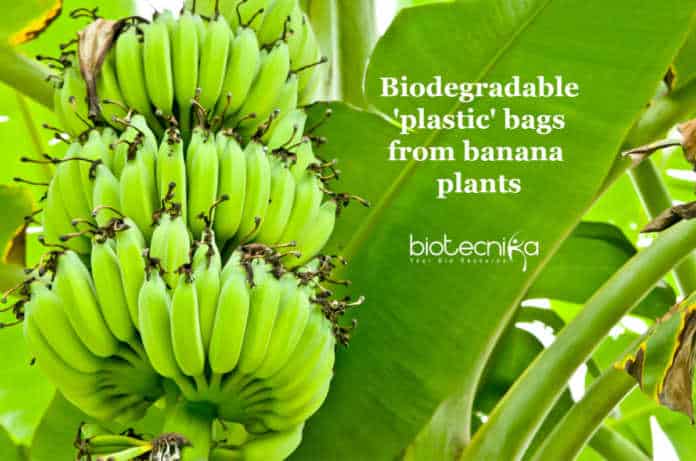Banana plants for packaging- An a-peeling Alternate to Plastic Bags.
Researchers discover a brand new way of eco-friendly packaging, using banana plants.
Two researchers from The University of New South Wales (UNSW) Sydney have discovered a unique way of solving plastic bags pollution. They have found a way to make biodegradable ‘plastic’ bags from banana plants, a solution to two industrial waste problems at once. They unraveled a novel way to turn the wastes from banana plantation into material for packaging which is both recyclable and biodegradable.
Associate Professor Martina Stenzel and Professor Jayashree Arcot were trying to find ways for converting agricultural waste into a usable material that would add value to the industry it came from while being able to solve problems for another.
According to A/Prof Arcot, the banana-growing in
dustry was a good option as it was observed to produce huge amounts of organic waste, with just 12% of the plant(the fruit) being used and the remaining being discarded after harvesting.A/Prof Arcot, UNSW School of Chemical Engineering, said: ” The fact that the banana plant dies after each harvest is what makes the banana-growing business particularly wasteful when compared to other fruit crops. The pseudostems in the banana plants caught our attention. The fleshy trunk of the banana plant makes the pseudostem. They are cut down after each harvest and are mostly thrown away on the field. Some of it is made use as compost, for textiles, but excluding these, it is a huge waste.”
Cellulose is an important component found in the cell walls of plants. It can be used in textiles, paper products, packaging, and even medical applications like drug delivery and wound healing. A/Prof Stenzel and Prof Arcot (UNSW School of Chemistry) were curious to know if the pseudostems were valuable sources of cellulose.
From the banana plants grown at the Royal Botanic Garden Sydney, a reliable supply of pseudostem material was used and the two researchers started to extract the cellulose to test its suitability as a packaging alternative.
A/Prof Arcot says, ” Pseudostem being 90% water, the solid material ends up reducing down to around 10%. In the lab, we got the pseudostem and chopped it into pieces, using a drying oven, dried it at very low temperatures and then milled it into a fine powder.”
Prof Stenzel continues saying, ” Then using a very soft chemical treatment, this powder is washed. Doing this, the nano-cellulose is isolated and this is a material of high value with various applications. Among the applications, we were greatly interested in using it for packaging, especially as single-use food packaging where so much ends up in the landfill.”
The material had a similar consistency to baking powder when it was processed.
The material from the banana plants could be used in many different formats in food packaging, depending on the intended thickness. We could try making it into a shopping bag. We could also make the trays for meat and fruit, depending on the way we pour the material and how thick we make it.
They performed tests to check the biodegradable nature of this packaging material from banana plants. The results confirmed that the material organically breaks down after ‘films’ of the cellulose material are put in the soil for about 6 months. Results confirmed the sheets of cellulose disintegrated in the soil samples.
Professor Arcot says, ” One of our Ph.D. students proved that we can recycle this material from the banana plants, for about three times without any change in its properties and hence proving the material as recyclable.”
There were no contamination risks in the tests with food items.
Professor Stenzel said that to check if there was any leaching into the cells, they tested the food samples, and none of them had any. She also tested it on cancer cells, mammalian cells, T-cells and all of these are non-toxic to them. If the T-cells are not affected, as they are most sensitive to anything toxic, then it is very benign.
They have also looked into other uses of agricultural waste like in the rice-growing industry and cotton industry, and they have extracted the cellulose from both of these.
Prof Stenzel says, “Theoretically, nano-cellulose can be got from every plant, but it’s just that certain plants are better than others and they have higher cellulose content.”
A/Prof Arcot added saying the fact that banana plants are an annual plant makes these so attraction adding on to its quality of the cellulose content.
It would make sense for the banana industry to start processing the pseudostems into powder and then sell it to packaging suppliers and this could make this banana pseudostem a realistic alternative to plastic bags and use the banana plant for packaging.
Prof Acrod said that a much better option for us and the banana industry would be if the industry people informed their farmers or growers about the value of making powders from pseudostem which can be sold later.
Using banana plants for packaging by using banana pseudostems stands a real chance of being a plastic alternative if the packaging manufacturers updated their machines, fabricating the nano-cellulose film into bags and other food packaging materials.
Prof Stenzel says, “At this stage, what we are really looking for us an industry partner who could figure out how to upscale this and make it an affordable alternative.”
A/Prof Arcot says, ” If the packaging companies knew that the material was readily available, then they would be more willing to have a try with this material.”
Author: Prathibha HC






























